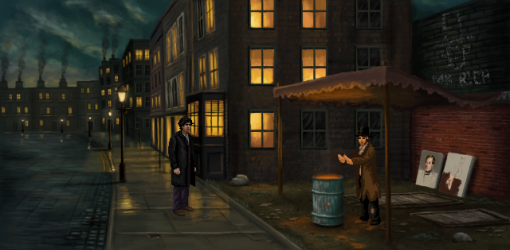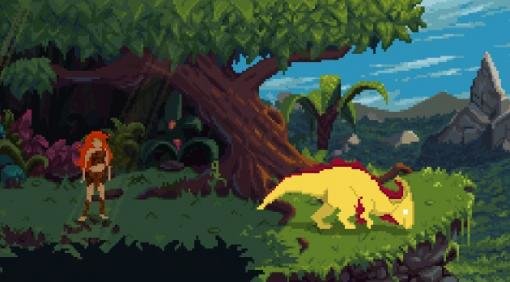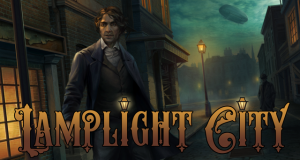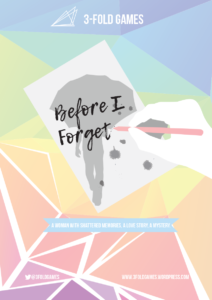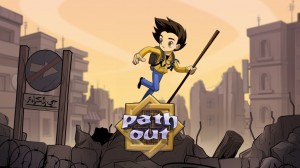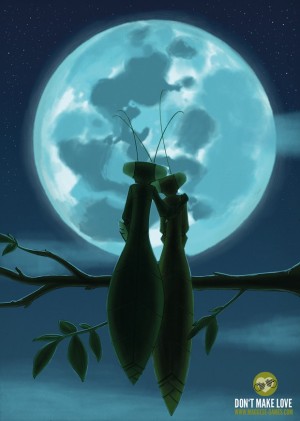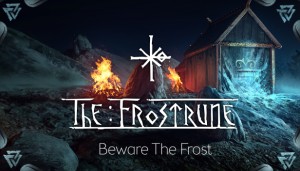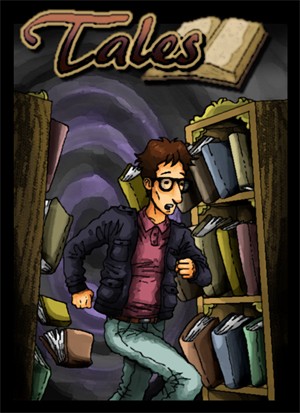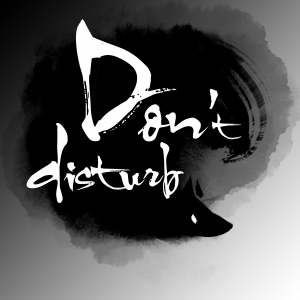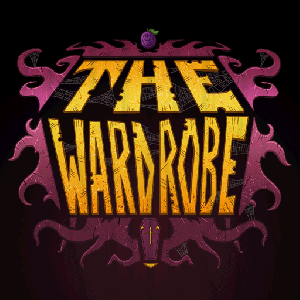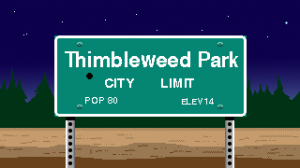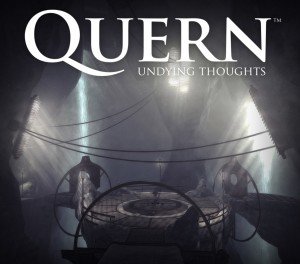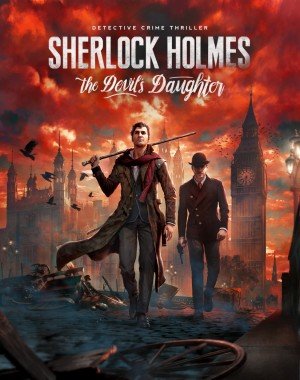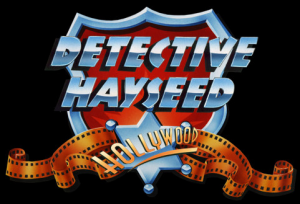AdventureX 2017 round-up: Part 2
Events Coverage
Reporting from E3, GDC, AdventureX, Gamescom and other gaming events around the world

It was a weekend of familiar faces and new friends. It was also a weekend of seeing several former freeware games expanding into fully commercial releases. I learned about a new text adventure engine, still in development, that may well be the basis of future AdventureX games. I also added to my photo album of game developers waving to my wife, including Brian Moriarty and James Dearden (my wife actually having provided voice-overs for one of the latter's games). Yet there were still more games to be played, so in addition to the first round-up of adventures on display, here is the rest of our 2017 coverage from London.
Gibbous: A Cthulhu Adventure
Private eye Don Ketype is a man on a mission, sent to retrieve the Necronomicon from the creepy local library. Young librarian Buzz Kerwan meets his request with scepticism, assuring the sleuth that the book is entirely fictional. But when cultists blow up the library foyer and kidnap Don, the book almost literally falls into Buzz's hands. Inadvisably reading from the dread tome and then wishing his cat Kitteh could talk, he suddenly finds himself with a very vocal feline. Just what eldritch forces has he unleashed?
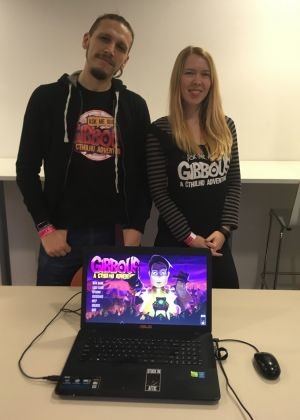 |
Liviu Boar and Cami Cuibus |
Developers Stuck in Attic describe Gibbous: A Cthulhu Adventure as comedy cosmic horror, or Lovecraft by way of classic LucasArts. Whilst the LucasArts influence does come through, the hand-painted graphics here are more detailed and modern than those games. The start of the demo saw Don climbing the long staircase to the library. The gothic town depicted in the background was actually inspired by the architecture of the developers' home town in the Transylvanian area of Romania. The library is similarly detailed, with tall unsteady shelves crammed with books. Full voice acting is planned but not currently implemented, though the game did feature environmental sound and gentle background music.
Clicking on a hotspot brings up a selection of actions, with only those relevant to the particular hotspot appearing. The spacebar reveals hotspots with a gentle glow that does not overwhelm the view. The intention is that you will control two characters over the course of the game, detective Don and librarian Buzz. You will also be able to ask Kitteh to do things, although, being a cat, she will not always be amenable to direction. The opening involved a brief conversation as Don, before switching to Buzz. A relatively simple puzzle revealed the forbidden book, which kicked off the main plot.
Further information, including a (different) demo, can be found on the game’s website while we hopefully await a first-quarter release in 2018.
Lamplight City
The year is 1844, and the city of New Bretagne is beset by crime. Together with his partner Bill, detective Miles Fordham pays a visit to a flower shop to investigate a most peculiar transgression. Someone has been breaking into the shop at night, taking flowers and leaving money for them on the counter. Whilst the proprietor, who does not have high opinion of the police, was happy to let it lie, her assistant was worried. This case will prove fateful for the investigative duo, as a confrontation inevitably ends in tragedy that has far-reaching implications for the rest of the game.
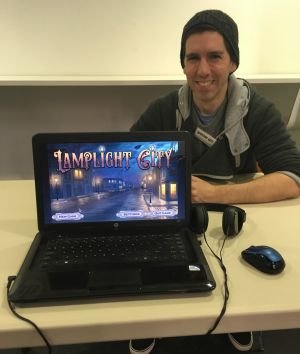 |
Francisco Gonzalez |
The graphics are similar to high-resolution versions of the Ben Jordan freeware series, which isn’t surprising since Francisco Gonzalez is also the main developer of Lamplight City. The setting comes across as an alternate version of Victorian London, with a steampunk vibe to set it apart. On the dark streets, lamps cast shadows over the pair as they travel. Within the shop itself, a vast array of colour is on display in the well-lit sales area. Action is backed up by dynamic strings playing a tune suited to the historical mystery setting.
Control is classic point-and-click. The demo covered an initial case to set up the story for the main game, but Lamplight City will have five other cases, with multiple suspects in each. In an attempt to break away from the norm, it is possible to accuse the wrong person, or even render cases unsolvable by your actions. Players should be careful not to do so too often, as this will bring about the downfall of the lead detective. Conversation played a large part in this initial case, with the interface showing close-ups of the characters in a way that mimics the interface of the first Gabriel Knight game. A casebook was only ever just a click away, storing clues, objectives, suspects and documents found.
While we wait for the game's targeted spring release next year, further information can be found on the developer's website.
Growbot
A remote station has come under attack from a dark and mysterious force. This assault has resulted in strange crystals springing up all over the place. With communications down, a little Growbot on the lower decks will have to fend for itself. With scant knowledge of the station or its strange inhabitants, things look bleak for the small automaton. But this brave little robot is not dissuaded, and sets out to get back to the rest of the crew and drive the attacker back.
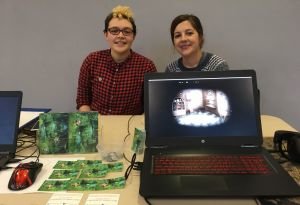 |
Izzi Mear and developer Lisa Evans |
Growbot’s graphical style is reminiscent of Samorost, but designer Lisa Evans has not simply copied Amanita’s style and called it a day. The soft-focus hand-drawn graphics are full of new ideas and creations, most notably the Growbot itself. This robot has a huge glass bowl forming the top half of its head, placed atop a comparatively tiny body. The problems this disparity naturally causes are illustrated in the protagonist’s decidedly wobbly walk. I personally found this particular animation so delightful, I would stop to move Growbot whenever I passed Wabisabi Games’ stand, just to see it again. This attention to detail carries over to the rest of the graphics, making this game a visual treat. Sounds I heard were limited but effective, mostly consisting of environmental ambience. A scratchy effect, as if being played on an old record, actually fit well with the otherworldly atmosphere.
Using simple point-and-click controls, the demo started in Growbot's bedroom, with a few small puzzles to get started. There is also an important item to pick up here, the Growbot manual, and you cannot leave without it. This starts off with only a few bits of information, but fills in as you discover more about the station and the other creatures living there. In a nearby cabin I found a creature called a Brainapilla, which was happy to take up residence in my oversized cranium. Once acquired, this creature can be used on hotspots encountered, serving as an additional source of information. Another puzzle I came across but did not resolve involved a recipe I found near a jam-making machine. The game's slightly surreal tone came through in this, as I had never considered the need to remove white and black holes from jam before.
With final release not scheduled until early 2019, for now you'll have to make do with the additional information found on the game's website.
Theropods
Living in the time of dinosaurs is a harsh existence. The great creatures can be wily and, if you are not careful, extremely dangerous. Unfortunately, you cannot always rely on your fellow tribesmen to assist you in hunting them, as a young cavewoman discovers when she arrives at the hunting ground. One of her companions is precariously balanced up a tree, whilst the other has fallen foul of one of his own traps. This is only the start of her problems, as a visit by a strange being will soon have an enormous effect on her life.
 |
Sarah Duffield-Harding and Kostas Skiftas
|
A small, Flash-based version of SeethingSwarm’s Theropods was made for Adventure Jam 2015. Now shifted to the Unity Engine, the commercial version expands greatly on the original concept. The same low-res pixel art style has been retained, though the characters are still quite distinctive, including the protagonist with her flowing red hair. The demo was set within a smoothly animated jungle, with muddy tracks and towering trees covered in vines. The game is technically fully voiced, though given the primitive setting, all the dialogue is grunted. The music I heard was a slow and simple piece, similar to the late part of the film 2001: A Space Odyssey.
Control is point-and-click, and the initial task appears a relatively simple one. You simply need to catch a small dinosaur to provide meat for the tribe. Sadly, this particular creature seems well aware of humankind’s threat, and fled to a different location each time I approached. The key seemed to be in building a simple trap, and directing my two companions to help drive the dinosaur into it. Except they didn’t seem too bright, the tree-bound one dropping on his face just after the dinosaur left, so getting them to help was a challenge. Fortunately, a bright glow indicates when you are pointing at a hotspot, so at least the bait and parts I needed to build the trap were easy to locate.
A release date is still to be determined. For a sneak preview of Theropods in action, however, a selection of animated GIFs can be found on the game’s website.
The Almost Gone
A young girl is trapped in the limbo between life and death. Imprisoned in this surreal reality, apparently imperfectly drawn from her own memories, she must work to decide her ultimate fate. In the real world, only a single second will pass. When that time is up, which side of the divide will she end up on, and will she help others with the same problem on the way?
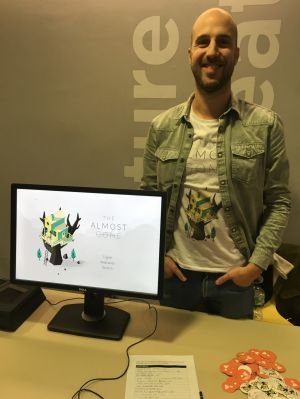 |
David Primsmel |
Developed by Happy Volcano, The Almost Gone revolves around the subject of mortality. The story was written by Joost Vandacasteele, a writer who has been published in both Belgium and the Netherlands. The game is to be split into several levels, each taking place within a particular location. The demo on display was set in a flawed copy of the protagonist’s home. She finds this place disturbing, as the contents are not quite as they should be and it appears devoid of other inhabitants. A minimalist art style is used, with a limited pastel colour palette. The view is isometric, with two of the four walls of the current location visible. An on-screen button rotates the view 90 degrees at a time, allowing the player to see the other walls, along with items previously hidden behind other objects. The accompanying soundtrack is a sonorous echoing chime that mirrors the minimalist visual style.
Control is entirely point-and-click, including buttons to move between rooms. The demo covered the entire first level, which is already considered complete. There was a great deal of exploration to be done, with a keen eye needed to spot all the useful items around the house. There were also puzzles in the form of lock combination challenges. It is possible that some of these will be adjusted further, as many attendees struggled to put all the clues together. There were also hints of the greater world beyond, with a small tree in the toilet an exact likeness of the one holding the girl’s treehouse in the real world. I was also shown screenshots of later levels, including a more open garden space containing another spirit in need of help.
The second level is almost ready to be implemented, with the final game planned to have four levels in all. The projected release date for the finished game is late 2018. More information can be found on the official website.
Before I Forget
Why did you come? Are you meant to be here at all? There is so much here that seems vaguely familiar, and yet you don’t remember any of it clearly. Perhaps if you look around, it will start to come back to you. Isn’t Dylan supposed to be here as well? Can Dylan help?
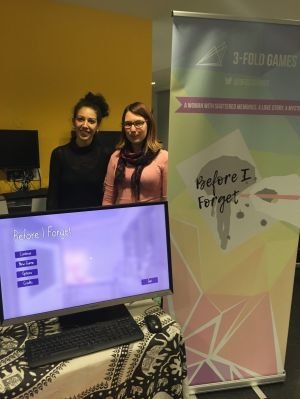 |
Chella Ramanan and Claire Morley |
With Before I Forget, 3-Fold Games have produced a game with a subtly disturbing psychological theme. At first I thought the game had crashed on me, as the graphics were blurred beyond recognition. However, a bit of sweeping around the screen soon located the protagonist’s glasses, revealing a first-person view of a hallway. Whilst overall realistic in style, the colours in this hallway had a washed-out look at the beginning. Using a console controller to move down the corridor, I soon found objects that I could interact with, a large label appearing when I was looking directly at any of the generously sized hotspots. Clicking on these caused text-only memories to appear on-screen, though the lettering was very shaky and soon dissolved away. These interactions also caused nearby parts of the environment to become painted in more vibrant hues. Sound initially consisted solely of environmental audio, though a late interaction triggered a pleasant piano piece.
Whilst only a fairly short taster, the demo proved effective in conveying the central concept. It was truly disturbing to be put in the shoes of someone who had apparently forgotten so much of their past life. The thoughts of the protagonist were unsettling, with the peculiar fade-out of the text akin to memories slipping away. This feeling was heightened by the environment itself proving unreliable, with a section where doors that had previously led into rooms suddenly all opening into the same cupboard.
The game is projected to be released in late 2018. More information can be found on the developer’s website.
Path Out
In 2011, young Abdullah lived in central Syria. Whilst there were some problems, most notably the power cutting out intermittently (and always just before he reached a save point in his game), he had a comfortable life. But as unrest in the country grew, his family became more worried about his safety. So, whilst still young, they set him off on a journey to get out of Syria and find a safer place to live. The journey will not be an easy one, and he will face danger every step of the way.
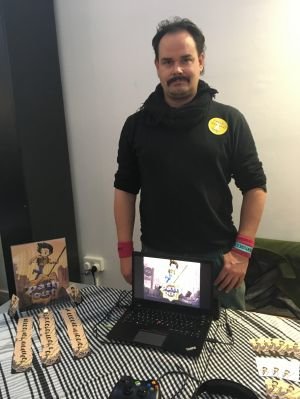 |
Georg Hobmeier |
Based on the real-life experiences of Abdullah Karam, who wrote the story of Path Out and appears throughout the game to deliver personal commentary on his experiences, this is a harrowing real-world tale, only the first part of which has been released so far. The developers, Causa Creations, have used the RPG Maker engine, with the presentation thus having a birds-eye, retro RPG look. This is supplemented with more detailed hand-drawn close-ups of the characters speaking when you engage in conversation. The game also has dynamic lighting effects, with the opening nighttime scene in a forest clearly visible in only a small area around the protagonist. The music also fits well, having a Middle Eastern feel.
Control of movement and interaction is handled entirely through the keyboard. The demo’s opening scene was set later in the journey, at which point Abdullah finds himself abandoned by a smuggler. The forest around him appears to be surrounded by minefields, and the only unmined exit proves equally hazardous. Finishing this section took me back to 2011, and happier times with the boy’s family. I got to meet several family members and go on a fetch quest for a lamp, which required me to get another item first. This served to set up the premise and establish necessary background, giving a solid grounding for the rest of the story.
The game is available for free on Steam, with future episodes continuing Abdullah's journey through Turkey, Greece and the Balkans to his destination in Central Europe, which will be subject to a small fee to cover development costs. Further information can be found on the game’s website.
Don’t Make Love
It is an age-old story. A young couple, deeply in love, are pondering taking their relationship to a more physical level. However, for this particular pair, that creates a peculiar difficulty. Being praying mantises, they are only too aware that having sex may lead to one of them not surviving the experience. Can their love prove stronger than animal instincts?
 |
Dario D’Ambra |
Maggese’s Don’t Make Love presents a love story with a difference. Players are given the choice of controlling either the male or female partner at the start. The meat of the gameplay is a text parser through which you type your side of the conversation. To a certain extent, the natural flow of conversation makes likely player responses predictable, but I was still impressed by how well the parser worked. It also avoided the “I don’t understand that” response so prevalent with lesser parsers. Instead, your partner’s response to an unrecognised sentence is to try getting the conversation back on track, indicating a suitable subject to use.
The graphics are a slightly stylised representation of the couple standing in a field of grass. The format is a slideshow presentation, with a soft fade between images. To break up the text-only conversation, you are able to change your mood or undertake actions via on-screen buttons. Moods such as happy and angry logically affect the tone of conversation as a result. Actions include hugging and kissing, with a brief series of images representing them. These choices also impact the music, with the simple tune going from joyous to melancholy as your mood changes.
The game is available now for Windows PC on Steam and itchio.io. You can also find more information on the developer’s website.
Detectiveland
It is 1929, and in the fictional city of New Losago, private investigator Lanson Rose faces another full day. Three cases present themselves: a simple missing person case, a house that may or may not be haunted, and a problem with the city’s liquor supply. With none of these cases proving as simple as they first appear, Lanson will have his work cut out for him.
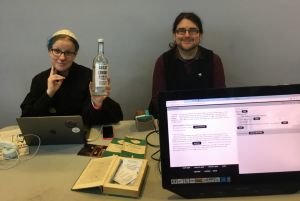 |
Isak Grozny and Robin Johnson |
If that story sounds familiar, that’s because it is the basis of the winning game from the 2017 Interactive Fiction competition. Having achieved well-deserved success with Detectiveland last year, Robin Johnson (aka Versificator in interactive fiction circles) is now looking at expanding on his original entry to make a bigger and more complex commercial game. The new version will include additional background art and an array of sidequests, discovered both by simply explore the city and as part of the main cases. Players who seek out and complete all the sidequests are to be treated to an enhanced ending, revealing more of New Losago.
For the convention, the demo was restricted largely to the original competition entry, though there were some minor graphical enhancements in the form of pictures of your locations showing as background to the action. The left side of the screen displayed the story text, presented in a font that looked like it had been printed with a broken typewriter with smudged and misaligned letters. The right-hand side included the interactive portion of the game, including your inventory, general actions and conversations with highlighted topics. Interaction is handled through these highlighted words rather than a full text parser, but the simpler control system definitely does not mean an easy game. Whilst the story appears at first to be a typical noir thriller, the content is decidedly tongue-in-cheek.
The game is on track for an early 2018 release. Further information, including a download of the original version, can be found on the developer’s website.
True Legacy
The year is 2084, and advances in detecting technology have resulted in most criminals being apprehended quickly. The same cannot be said for progress in other areas, with many in Hong Kong living in squalor. As a homicide detective, you are in a relatively privileged position, but it doesn't feel like it tonight. You are at the scene of a murder, and the killer appears to be highly sophisticated, having used a DNA shroud – a device intended to strew lots of extraneous genetic material to cover up the perpetrator’s own DNA – of extremely high quality. This is not going to be a simple case.
 |
Dejan Levi |
Blindfire Limited’s True Legacy is entirely text-driven, though it comes with minimalist semi-realistic stills to illustrate the action. Transition between locations is achieved by having a block of text with a black background scrolling to cover one picture and reveal another. This future Hong Kong is not a happy place, beset by constant rainfall and bearing more than a little resemblance to the dystopian world of Blade Runner. As well as the background pictures, there are some close-ups of devices you must employ.
Designed for tablets, the game text is scrolled, with decisions appearing at various points in the narrative. These are presented as a list of options to choose from to determine the next part of the narrative. There are occasional alternate avenues of investigation, indicated by on-screen arrows pointing off to the side in the location illustrations, indicating it is possible to reveal more story and clues in those directions. Players need to keep a close eye out for these, as the side routes often contain vital information. Highlighted words within the text can also be tapped to bring up definitions of the futuristic technology referenced. These should also be read carefully, as one contained a vital clue to resetting the AI device I was using to analyse the crime scene.

The game's release is not far off, but no launch date has yet been announced. More information can be found on the True Legacy website.
Returning Games
Last but certainly not least! With so many new games on display this year, it was tempting to skip the ones that Adventure Gamers has already reviewed or I'd seen and covered before and were making a return trip. But, with their creators’ enthusiasm for the genre adding to the overall convivial atmosphere, it seemed only fair that their contributions are duly acknowledged, if in a slightly less traditional way.
The Adventures of Bertram Fiddle: Episode 2 – A Bleaker Predicklement
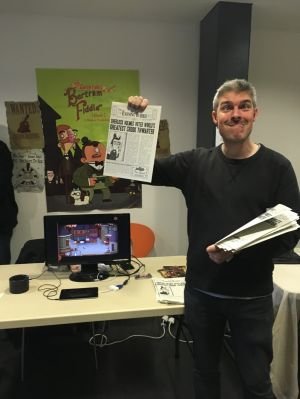 |
Seb Burnett |
Already available on Steam and the App Store, the second part of this tale of a Victorian gentleman detective is as humorous a spoof as the first. For AdventureX, lead designer and artist Seb Burnett produced a four-page paper, The Evening Burble. This included tales of pre-eminent crook thwarter Sherlock Holmes, adverts for upper lip stiffeners, and a stimulating word puzzle on the back. Sadly, Seb was unable to convince his daughter to dress up as an authentic newspaper-selling street urchin. His own attempt at filling the role in her absence was also less than convincing.
More information can be found at the Bertram Fiddle website.
Lancelot’s Hangover
 |
Jean-Baptiste de Clerfayt |
Immediately recognisable in his bright yellow t-shirt, Jean-Baptiste de Clerfayt brought his naughty knight tale back to AdventureX. His attempt to emulate his game hero at the post-convention Saturday drinks did not go as badly for him as might be expected. (Apparently our British beers are generally weaker than the Belgian kind.) He also had a friendly rivalry with Seb Burnett, whose paper included a less-than-flattering advertisement for Belgium. Whilst the game has been in development for some time, it was previously greenlit on Steam and is now aiming for a release in the first quarter of 2018.
More information can be found at the Lancelot’s Hangover website.
The Mystery of Woolley Mountain
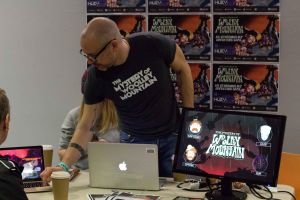 |
James Lightfoot at work |
Development on the cartoonish tale of Victorian scientists on a grand quest continues apace. Two parts are now considered complete, subject to final testing. With the final part also well along, the hope of releasing the finished product in early 2018 is looking increasingly achievable. Whilst taking up the same space as last year on the Saturday, a sudden illness prevented developer James Lightfoot from returning on the Sunday. I wish him a speedy recovery and hope we can look forward to seeing the finished results of Lightfoot Bros’ work soon.
More information can be found at the Mystery of Woolley Moutain website.
The St. Christopher’s School Lockdown
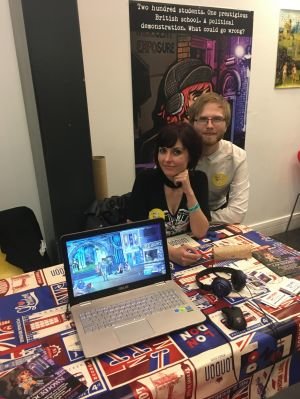 |
Laney Berry and Roger Benoit |
With their school-based drama released in October, the development team from Classroom Graffiti Productions took two very different approaches to dressing for AdventureX. Roger Benoit donned a smart dress shirt whilst his partner, Laney Berry, wore a more retro outfit that wouldn’t look out of place in the ‘60s student setting of their game. The very British location of St. Christopher’s was made clear by a tablecloth covered in patriotic imagery used on their display table.
The game can be purchased through Steam or itch.io.
Unforeseen Incidents
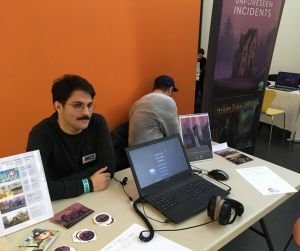 |
Tristan Berger and Matthias Nikutta setting up |
Whilst the original planned launch date of early 2017 was not quite achieved, this tale of a small town handyman facing a big conspiracy is headed for release soon on Windows, Mac and Linux as well as Android and iOS devices. Exhibiting at the show with their publishing partner, Application Systems Heidelberg, developer Backwoods Entertainment promise players an intriguing classic mystery with a unique art style and unusual setting.
More information can be found on the Unforeseen Incidents website.
Four Last Things
 |
Joe Richardson |
Having greatly enjoyed Joe Richardson's original freeware version of Four Last Things, I was looking forward to checking out the commercial version at AdventureX. This was, of course, entirely because I wanted to see the results of the hard work of a talented developer. The thought that I would publicly look like a genius thanks to my knowledge of the puzzles from the earlier edition hardly entered my mind at all. When I came to play this collage-based parody game about having to commit the seven deadly sins to gain absolution, my expectations were only partly fulfilled. On the positive side, Richardson has undoubtedly taken a brilliant and original idea and made it into a great looking and fun full game. On the negative side, in doing so, most of the puzzle solutions I thought I knew were changed to become harder, resulting in my not looking as brilliant as I had hoped. I still got a lot of enjoyment from this clever and humorous game, though.
Four Last Things is already available on Steam, and the developer hopes to release it on iOS and Android in the near future. Further information can be found on the developer’s website, and you can read our full impressions in our review of the game.
The Frostrune
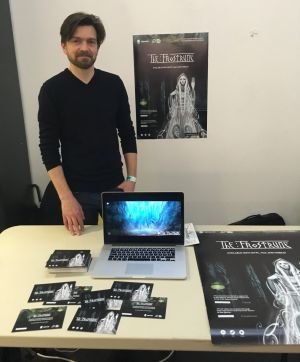 |
John Satrang |
Over the course of the convention, I kept meeting up with professional game translators from various countries. Unfortunately, they all stuck to translating modern languages, so no-one was able to help me understand the Old Norse used for all the dialogue (including some songs) within The Frostrune. That being the case, it is probably a good thing that the developer, Grimnir, saw fit to include English subtitles in their game. Both their posters and the cards they were handing out displayed, as their central feature, an image of a female spirit. Sure enough, with a modicum of exploration, I was able to locate the spectral lady herself within the game. Given her prominence on promotional material, and the stern command she laid upon me when we met, I have no doubt that she is central to this mystic first-person tale of the time of the Vikings.
The game is available on Steam, the App Store and Google Play. More information can be found on the developer’s website, as well as a detailed analysis in our complete game review.
Final Thoughts
 |
Steve bids a fond farewell from the cool chair |
It was another great year at AdventureX, with a wide variety of fun games to play. With some careful planning of my coverage this time, I even managed to get to some of the excellent talks as well. I managed to see Jon Ingold's hilarious tale of the highs and lows of the procces of creating Inkle's new game Heaven's Vault, illustrated by a handy graph. I also caught Brian Moriarty's intriguing story of how one of his game design lectures became an Easter egg in The Witness. I also finally achieved my dream, after many years of attendance, of being on the winning team in the quiz (a feat achieved through the cunning ploy of sitting on the same side of the lecture theatre as people who could answer the questions). As always, the atmosphere was friendly, with gamers and developers hanging out together to share their love of the genre. This convention shows just how much the genre is thriving, and I look forward to having more excellent games to write about next year.


